2020 has been a year of unexpected changes.
With the unprecedented impacts on many businesses, what will happen to SaaS? Is the future promising for SaaS businesses?
SaaS has been acing the technological world for the past 2 decades. And now, the pandemic times leaves another important impression.
SaaS technology is a business savior.
SaaS is here to stay, but the stay will not be static.
Changes shape the growth of SaaS. Now with the name and fame, SaaS must have a lot in store. And as a SaaS enthusiast, knowing the trends that await puts you in better preparation.
Are you ready to explore future trends? Let’s dive in.
Brief intro of SaaS
Software-as-a-Service (SaaS) is a cloud-based technology, where users can access and utilize the software using the internet.
SaaS has many benefits on the user side. But, is the picture happy on the provider’s end?
It’s a clear yes.
Generally, SaaS products are priced on the subscription-based model.So, as a SaaS provider, you will have regular revenue in your pockets. Added that you have a satisfied and happy customer base.
Also, building and maintaining a SaaS product is cost-effective when compared to traditional models. You can also easily improve and refine your products with time.
A Glimpse Of SaaS’s Journey
SaaS has been around here for almost 60 years.
Back in the 1960s, computers were large and very expensive. Considering this drawback, IBM and a few other mainframe providers introduced the concept of ‘rented computers’.
The mainframe contained the computing power and storage space. Multiple users were able to access and use them through the multiple ‘dumb terminals’. This technology was of great help for small business firms who couldn’t afford the expensive computers.
And this system, also known as ‘time-sharing’ or ‘utility-computing’ was the earliest form of SaaS.
The system of renting computers continued till the 1990s. In the 1990s, cheap computers came into the picture. Computers became affordable for almost many people. This eliminated the need for ‘rented computers’.
But the concept of SaaS didn’t end there.
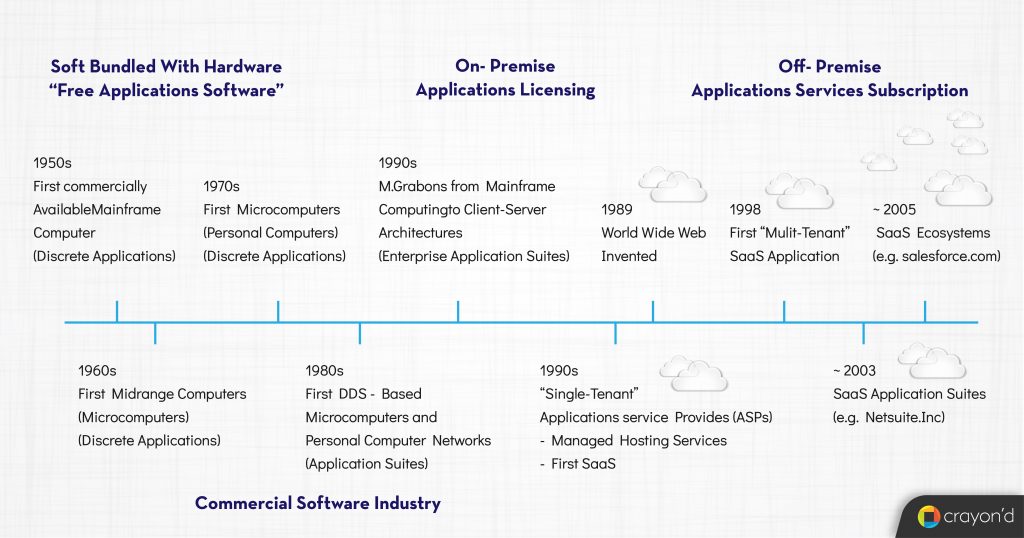
LAN ventured to expand the internet community. And, ASPs (Application Service Providers) emerged. ASPs advocated the idea of centralized computers. ASPs hosted and maintained the service created by third-party vendors, on the internet.
SaaS derived its idea from ASP. But the SaaS companies differed from ASPs’ as they built their own product. Owing to many issues and inefficiency, ASPs failed. SaaS sustained.
The growth of SaaS after the 2000s can be seen alongside the growth of Salesforce. Salesforce is one of the first SaaS companies. It provided CRM based services completely based through the web.
Beginning years, Salesforce advocated ‘End of Software’ campaigns to make people realize the advantages of the cloud.

Drawing people into cloud-based services and making them aware of the huge advantages, Salesforce began to grow effectively.
Salesforce along with few other initial SaaS companies was instrumental in popularizing SaaS and driving people to adopt cloud services. With this exposure, people understood the major benefits of SaaS and started shifting to it.
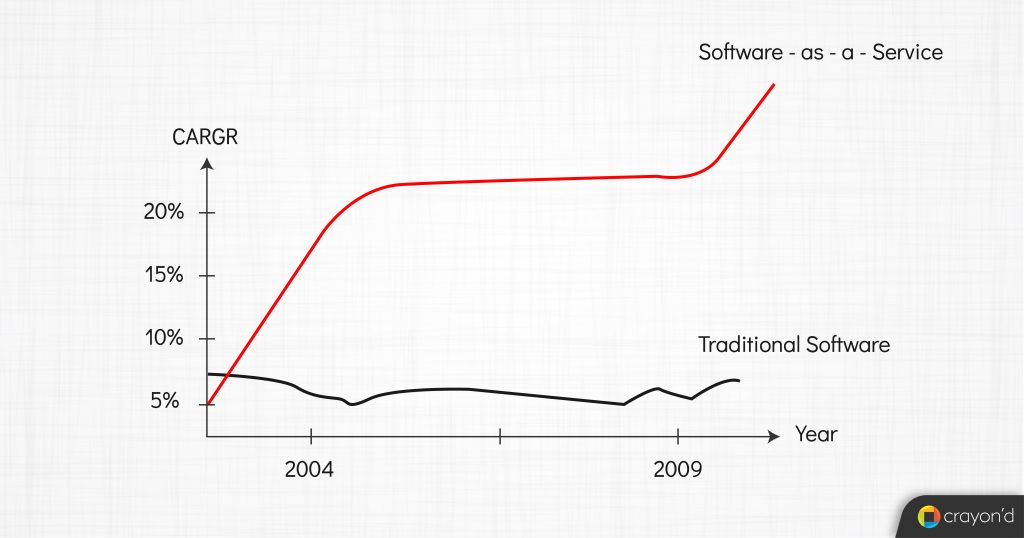
The advent of Google, Hubspot, Amazon, and many other SaaS pioneers made SaaS grow steadily.
SaaS in 2020
Now, in 2020, we are witnessing SaaS spreading its branches into various fields. Some are well-established branches, while some are tender and growing. A glance of fields SaaS is into:
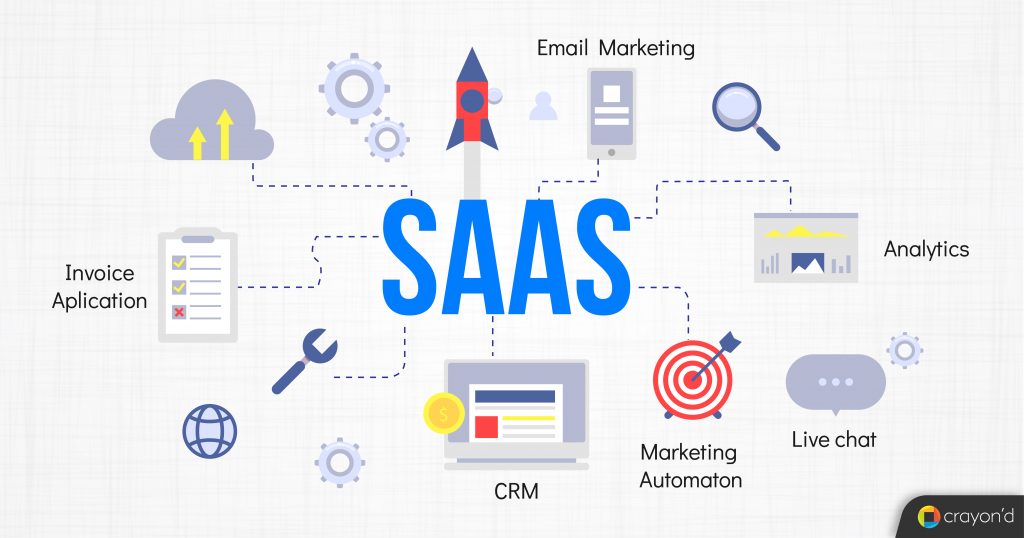
According to Virayo, there are 11,000 SaaS companies operating in the world. Another report from Blissfully shows that,
- Companies with 1-100 employees use 102 SaaS apps on average
- Companies with 101-1,000 employees use 185 SaaS apps on average
- Companies with 1,000+ employees use 288 SaaS apps on average

SaaS is an ever-evolving field. Needless to say, the SaaS market is filled with competition. Among all the hustle, how do you make your product/company stand out?
Keeping an eye on and incorporating these trends into your product ideas and goals can help you achieve that.
SaaS Benefits for the users
Thinking of SaaS growth, you will probably be wondering,
‘Why do people seek this SaaS technology?’ Here’s your answer— the benefits a user gains from SaaS.
- No infrastructure costs
Everything is cloud-based in SaaS and you can access it through the web. This eliminates the costs of physical installations in the building.
- Scalable according to business needs
SaaS is easily scalable. If a business expands, it can switch the plans to accommodate the changes. And the vendors take care of the rest.
- Painless updates
Unlike the traditional software where the new release packages need to be purchased, it’s much easier in SaaS. Updates are just a few clicks away.
- Accessibility
Well, we all are aware of the term ‘remote work’ now. SaaS enables the users to access from anywhere, which is empowering the business in times of the pandemic.
- Affordable
In addition to the advantage of eliminating infrastructure costs, SaaS is affordable. The companies can opt for plans based on their size and need not spend beyond their capacity. The subscription model saves you from spending money without actual usage.
SaaS Adoption Trends
The world went upside down during the pandemic. But SaaS: it just did not just hang in there, it excelled.
SaaS helped businesses to thrive, operate and stay connected. Seeing this happen, a few other businesses opted to switch as well. Many saw that SaaS was promising.
So, there has been a change in SaaS adoption rates. No doubts, it just went higher. Let’s look at some of the SaaS adoption trends in 2021.
- The SaaS market is currently growing by 18% each year
- By the end of 2021, 99% of organizations will be using one or more SaaS solutions (BMC)
- 93% of CIOs are adopting or planning to adopt cloud SaaS (Deloitte, 2020).
Some businesses around the world might retain the current remote working conditions. Owing to the certainty of work even in uncertain times, preference for SaaS will climb the upward curve.
SaaS Trends for 2021
SaaS is growing even during the crisis.
The Compound Annual Growth Rate is estimated to be 18.2% for the period 2020-2027. A forecast shows that worldwide SaaS revenue will reach 151.1 billion USD by 2022.

But in which areas will SaaS flourish? Trends are here to let you know that. Let’s begin to explore the trends.
Technological Trends
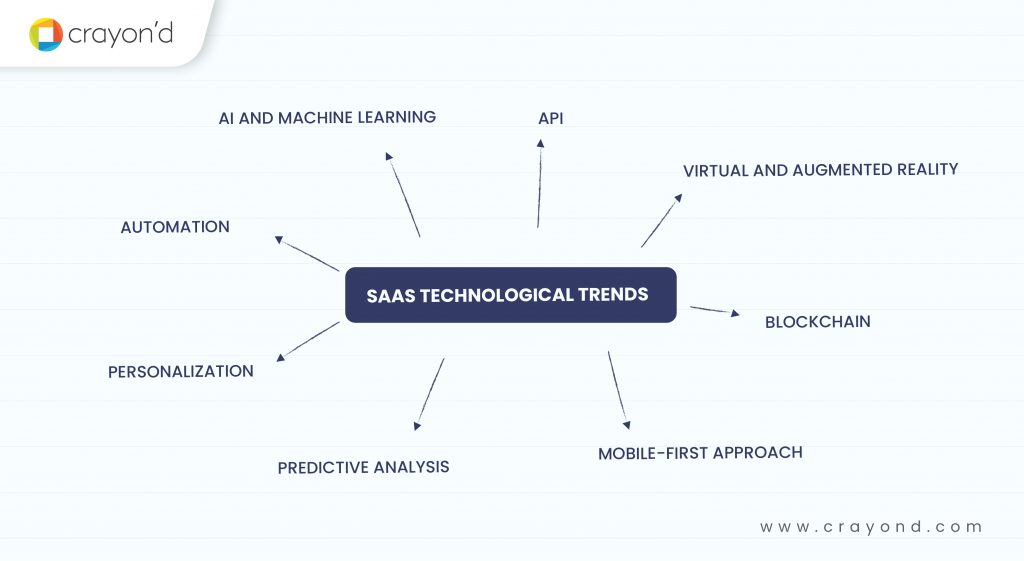
AI and Machine Learning
Artificial Intelligence and Machine Learning in the SaaS field are expected to bring so many changes that will make SaaS an even more sought technology.
Automation
Using Machine Learning technology, an automated response system can be implemented in SaaS.
Salesforce, one of the first SaaS companies, has incorporated automation in various areas of its CRM services.
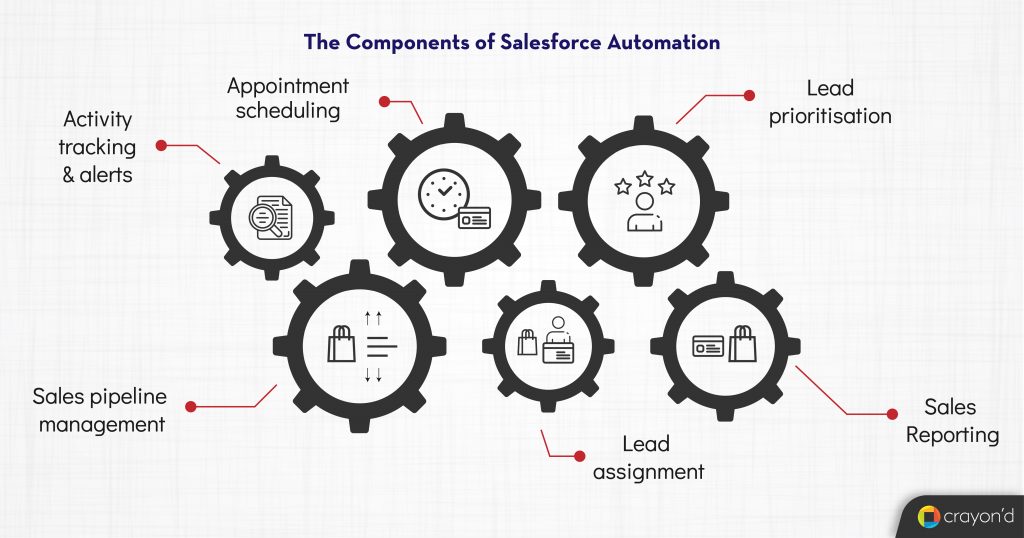
Let’s take one of the automation — ‘activity and alerts’ This feature helps you track activities related to customers and alert you whenever required. This makes you have a better commitment to customers.
Likewise, chatbots can be employed for initial conversations. This ensures timely and personalized communication with customers.
Advantages brought in by automation are immense and will be a trend-setter going ahead.
Personalization
Personalization is not just a sophistication now, it is becoming an expectation. From every message they receive to the service they opt for, customers love personalization.
Spotify is a cloud-based music platform. SaaS provides personalized playlists for its users using machine learning.
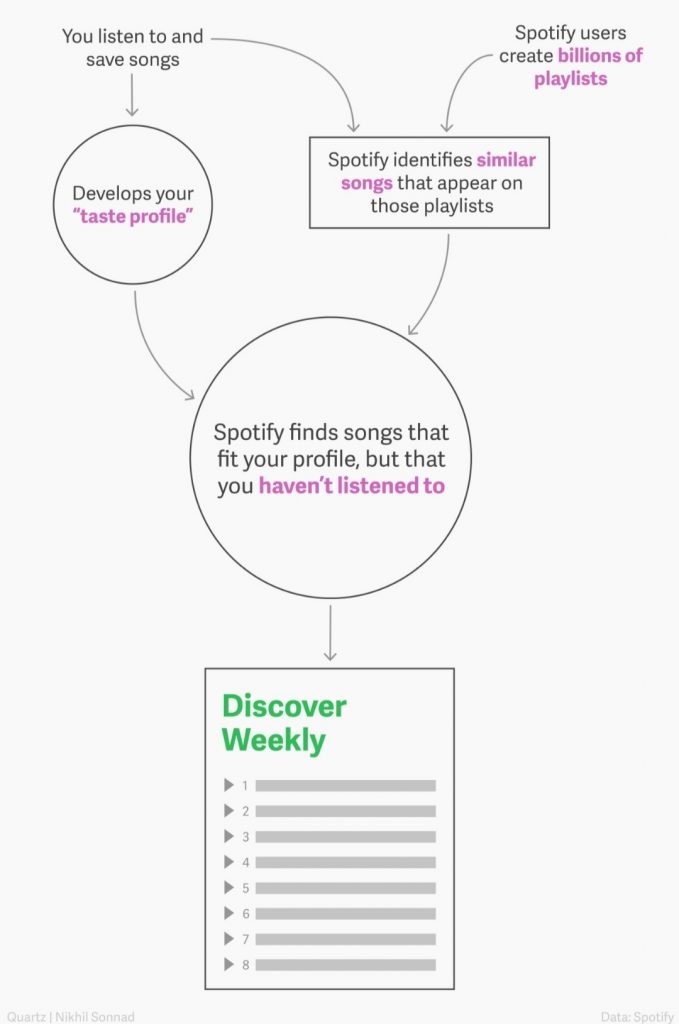
And the need for personalization will only grow in the upcoming years. Personalization can help improve customer engagement and provide customized service.
With AI’s data processing ability, personalization will be a piece of cake!
Predictive Analysis
How many times have you thought, “I wish I knew it earlier”?
Well, now with the predictive analysis you can save that dialogue in terms of business.
From knowing which one of your website visitors will possibly become a customer to which unhappy customer is about to unsubscribe to your service, predictive analysis can predict it all.
Making use of AI-based data, predictive analysis, among the other trends will be a goldmine for sure!
API
SaaS adoption is increasing. According to IDG’s 2018 Cloud Computing Survey, 73% of organizations have at least one application already in the cloud.
API helps in integrating two or more apps. Your customer will have existing systems and software. And they expect the new software they purchase to be easy for integrating with existing ones.
Hence interconnection is greatly sought in the SaaS market.
Cloud Elements says that the software with easy integration facility have
- Reduced Customer Churn by 60%
- Increased Customer Lifetime Value by 15%
Enough reasons to look into enabling API integration for your SaaS products.
Virtual and Augmented Reality
The truth is deep down we all love fiction.
Virtual reality gives us a vision of the imaginary world while augmented reality adds imaginary elements to the real-life environment. Both are exciting for a human mind.
Both VR and AR can be implemented in SaaS and used in various fields such as education, healthcare, military training, manufacturing, navigation.
Ford motors employees are using VR software to design their new vehicles now.
Smith, one of the Ford Design managers, says that “It only took 40 hours to create a new vehicle design with the software. This is relatively very less time when compared to the designing period using traditional software.”
This trend opens a lot of possible opportunities for SaaS enthusiasts to explore.
Blockchain
SaaS works on centralized databases. Data in centralized cloud databases are vulnerable to attack. This is one of the major disadvantages in SaaS.
Blockchain technology is a distributed system. Blockchain system continuously verifies new data records. The technology also makes a copy of the entire blockchain when new records are added. Hence data loss can be prevented.
This eliminates the huge drawback of data insecurity.
Mobile-first approach
Don’t you think it’s exhausting to open a laptop, especially when we have mobile phones, that are just a swipe away to use?
Easiness in access is what people are looking for. Having a mobile-first approach is the best way to satiate them.Mobile phones are handy too.
According to GSMA, there are 5.20 billion unique mobile users in the world.
- A Google study suggests that 57% of Consumers do not recommend businesses with poor mobile websites.
- The study also shows that 40 percent of the visitor turns to a competitor’s website after they have a bad mobile experience.
Also, the usage of desktop for the web has been relatively low when compared to mobile.

And hence, making your product mobile-compatible is an important pointer to consider in years to come.
Type trends
Vertical SaaS
Among the two types of SaaS, horizontal and vertical, the latter is believed to grow in the future.
While horizontal SaaS covers a wide market, vertical SaaS is niche-oriented. One such example is HotSchedules.
HotSchedules is a restaurant management software. It helps in labor management, inventory management, cash management, and talent development in the restaurant business.
Vertical SaaS companies focus on a specific area of business. And so, they can provide customized services to users.
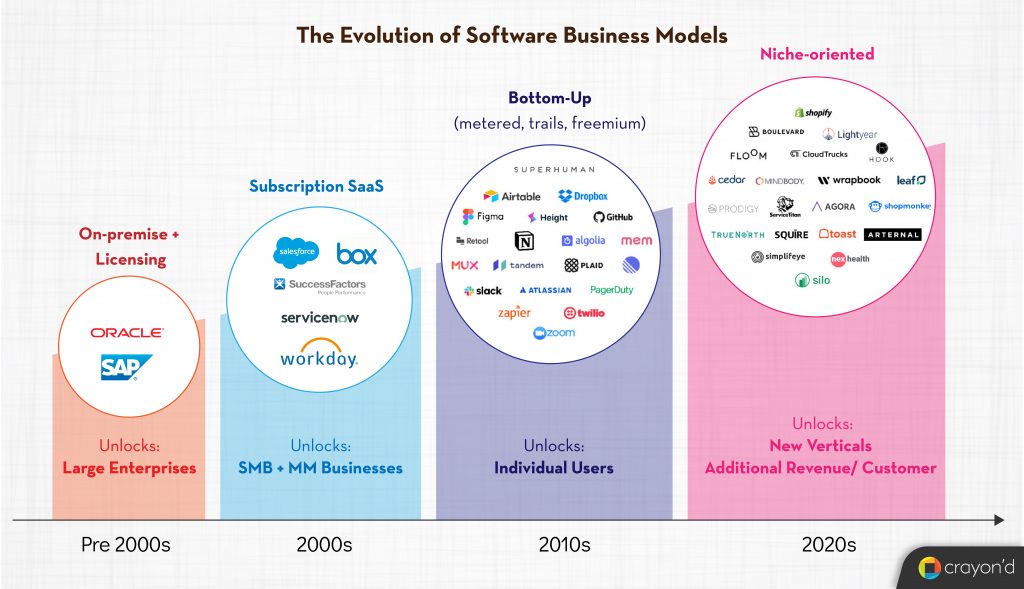
Customization is on-demand. The upcoming years are for Vertical-SaaS products.
Micro-SaaS
It’s in the smallest details lies the greatest satisfaction.
Micro-SaaS is also niche-oriented. It is run by one person or a small team. Micro-SaaS products are built for solving customer’s pain-point in using a product. They can also be add-ons for existing SaaS products.
A micro-SaaS product built with the intent of solving customer’s pain points/ problems will only succeed.
Let’s take Grammarly. Almost every email user feels the need to proofread the content. A mail with basic language error may cause embarrassment on the sender’s side and disappointment on the receiver’s end. Grammarly understood this and created a solution.

Grammarly can be used as an add-on/plugin wherever text correction is required. Now it has almost 10 million Daily Active Users.
People are looking for perfection and a better experience in every product they use. Hence micro-saas businesses will grow and develop in the future.
Other trends
Product-Led Growth
Product Led Growth is an approach where the customer-acquisition, expansion, and retention are done by the product itself. In short, your ultimate salesman is your product.
Customers don’t want to believe. They want to know.
A good user experience and a word of mouth from a satisfied user can earn you more customers. Hard to believe? There are already a few companies that have proved this point. One of them is Slack.
In 2014, Slack started off just without a sales team. The stats show the Daily Active Users of Slack in their first year. And the first 6-month growth was completely through word-of-mouth.

Wouldn’t you rather prefer a friend’s recommendation over the sales person’s? That’s how PLG works.
Also, we know that buyers are evolving. And it’s the end-user era. People only purchase after a satisfying experience with the products.
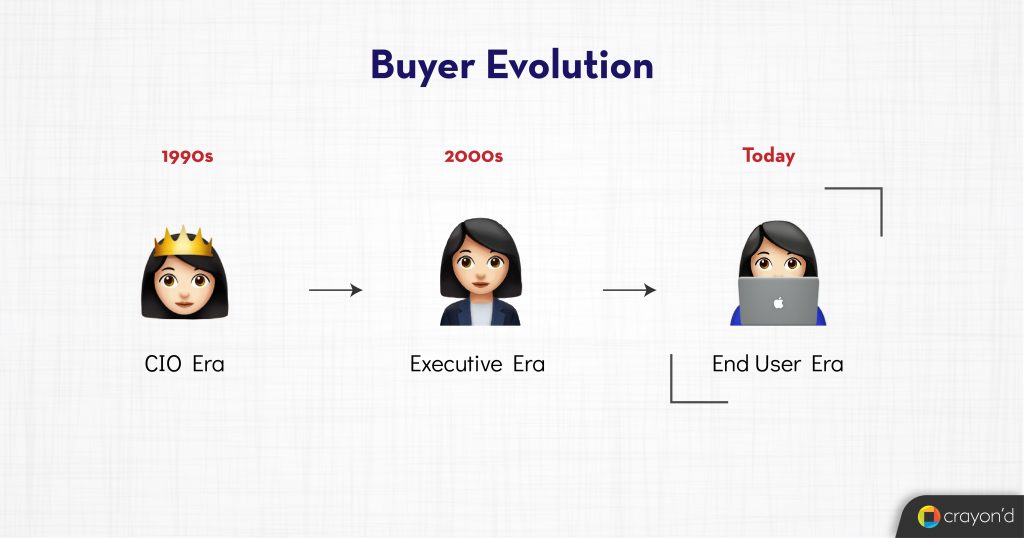
It’s a perfect time to consider a PLG strategy for your business.
COVID-19 and the SaaS market
Do you think businesses would have survived COVID-19 times without SaaS products? Absolutely not! Even virtual meetings were made possible through SaaS products like Zoom and Google Meet.


According to Aithority, SaaS is expected to have a $157 billion market share by the end of 2020.Remote working paved way for the increase in digitization. This indicates the growth of the SaaS business through COVID-19 times.
Post-Covid SaaS market
Companies are realizing the importance of remote access and cloud services. This puts SaaS products on demand. According to PR Newswire, the global SaaS market was estimated at US$68.2 Billion in the year 2020. Post-COVID the estimation has been revised to a size of US$219.5 Billion by 2027.
Even though SaaS is experiencing growth, people are facing a crisis. As per Zuoro, the SaaS businesses have the following impact with their subscriptions.

Also with the existing economic crisis, companies should shift their focus from acquiring new customers to the retention of the existing customers. Retention can be done by bringing certain changes to your subscription model.
1. By offering a free trial
2. By pausing memberships for a while.
3. By offering discounts.
With changing user needs and an economic crisis, SaaS companies should change their approach that caters to both.
Why is SaaS the future?
One great testament to the statement ‘SaaS is the future’ is the resilience it exhibited in the pandemic times. SaaS did not just get through the difficult times, but it aced.
SaaS helped the businesses survive even when the teams were apart, at their homes. The flexibility of SaaS in terms of scaling and payment was an added advantage.
Businesses that had adopted SaaS technology were up and running, while the others were stumbling. These realizations dawned upon the rest.
The pandemic was proof that you cannot expect or predict a disaster always. You have to be ready for the worse. With SaaS, you are armed for it. This crisis-resistance portrayed during this pandemic is one of the reasons ‘why SaaS is the future’.
Endnote
One of the major disadvantages of SaaS is the threat to data security. But the blockchain trend hints at a possibility of eliminating that too.
SaaS business proved that it is crisis-proof through the COVID times. The trends show that the SaaS market is open to many possibilities and opportunities.
Considering that SaaS is also where most AI and ML innovations are taking place, it will be easy to cope up with rapidly evolving user behavior and needs.
With AI’s data processing and handling abilities understanding users will be a cake-walk.
With such immense potential, you basically set yourself to lose money placed on the table if you do not pursue SaaS.
Sure that SaaS’s future is bright! Do you see yourself shining there?


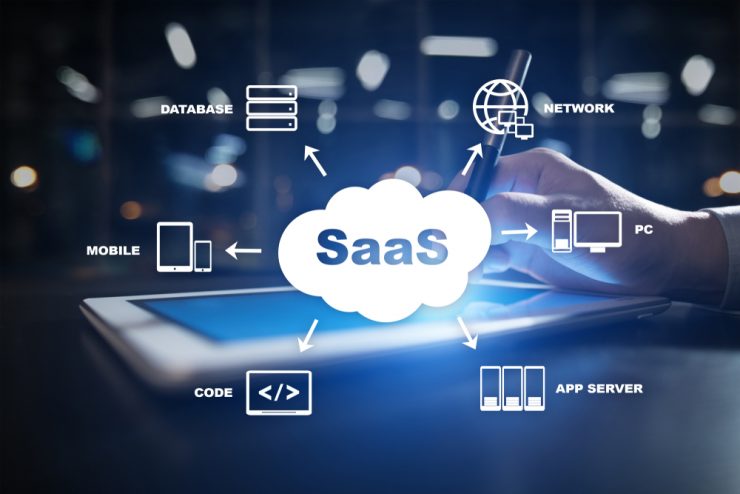




Add comment